Microstructure-Free Finite Element Modeling for Elasticity Characterization and Design of Fine-Particulate Composites
Abstract
1. Introduction
2. Effect of Inclusion Shape and Size on Elastic Properties of Particulate Composites
- All RVE models are in a cubic shape, and the sides have a length of 100 units. Since inclusion-to-RVE size ratio is of interest, the unit can be in any length from nanometer to meter.
- The composite is a particulate-filled glassy polymer [14]. The matrix material has Young’s modulus Em = 2.68 GPa and Poisson’s ratio Vm = 0.394, and the inclusion material has Young’s modulus Ei = 70.0 GPa and Poisson’s ratio Vi = 0.23.
- The volume fraction of inclusions in all models is fixed at 30%.
- The inclusions in a model have the same shape, i.e., either spheroid, almond-shaped, or pill-shaped.
- The inclusions in a model have the same size. The inclusion-to-RVE size ratio is gradually reduced from 0.8 to 0.02 in the series of models, by decreasing inclusion sizes.
- With the inclusion-to-RVE size ratio approximately smaller than 0.04, the RVE elastic properties are almost not affected by the inclusion shape and size.
- Anisotropy in the RVE elastic properties, which is measured by the error bars in Figure 3, is gradually reduced and then disappears with the decreased inclusion-to-RVE size ratio.
3. Microstructure-Free Finite Element Modeling of Particulate-Composites
- A cubic RVE with side length of 100 units is constructed. The unit can be at any length scale from nanometer to meter, depending on the composite material to be studied.
- The RVE is meshed with brick elements of the same size, which is determined by the critical inclusion-to-RVE size ratio, i.e., 0.04 to 0.02 times the RVE side length, as discussed in the previous section. All the elements are first assigned with the properties of the matrix material.
- Then, a number of the elements is randomly selected and re-assigned with the properties of the inclusion material. The number of the selected elements is determined by the desired volume fraction of inclusions and the volume of each element. Samples of such microstructure-free finite element models are shown in Figure 4.
- Then, the boundary conditions described in Table 1 are applied, and finite element analyses are conducted.
- RVE properties such as Young’s modulus, shear modulus, and Poisson’s ratio are calculated using Equations (1)–(4).

4. Validation of MF-FEM against Experimental Data and Comparison with Popular Micromechanics Models
5. Discussion
6. Conclusions
Funding
Institutional Review Board Statement
Informed Consent Statement
Data Availability Statement
Conflicts of Interest
References
- Raghavan, P.; Li, S.; Ghosh, S. Two scale response and damage modeling of composite materials. Finite Elem. Anal. Des. 2004, 40, 1619–1640. [Google Scholar] [CrossRef]
- Gad, S.I.; Attia, M.A.; Hassan, M.A.; El-Shafei, A.G. Predictive computational model for damage behavior of metal-matrix composites emphasizing the effect of particle size and volume fraction. Materials 2021, 14, 2143. [Google Scholar] [CrossRef]
- Ferdous, W.; Manalo, A.; Yu, P.; Salih, C.; Abousnina, R.; Heyer, T.; Schubel, P. Tensile fatigue behavior of polyester and vinyl ester based GFRP laminates—A comparative evaluation. Polymers 2021, 13, 386. [Google Scholar] [CrossRef]
- Gusev, A.A. Representative volume element size for elastic composites: A numerical study. J. Mech. Phys. Solids 1997, 45, 1449–1459. [Google Scholar] [CrossRef]
- Sherwood, J.D. Packing of spheroids in three-dimensional space by random sequential addition. J. Phys. A Math. Gen. 1997, 30, L839. [Google Scholar] [CrossRef]
- Cooper, D.W. Random-sequential-packing simulations in three dimensions for spheres. Phys. Rev. A 1988, 38, 522. [Google Scholar] [CrossRef]
- Adamczyk, Z.; Weronski, P. Random sequential adsorption of spheroidal particles: Kinetics and jamming limit. J. Chem. Phys. 1996, 105, 5562–5573. [Google Scholar] [CrossRef][Green Version]
- Buryachenko, V.A.; Pagano, N.J.; Kim, R.Y.; Spowart, J.E. Quantitative description and numerical simulation of random microstructures of composites and their effective elastic moduli. Int. J. Solids Struct. 2003, 40, 47–72. [Google Scholar] [CrossRef]
- Torquato, S.; Uche, O.U.; Stillinger, F.H. Random sequential addition of hard spheres in high Euclidean dimensions. Phys. Rev. E 2006, 74, 061308. [Google Scholar] [CrossRef]
- Zhou, J.; Qi, L.; Gokhale, A.M. Microstructure model for discontinuously reinforced composite by modified random sequential absorption method. J. Eng. Mater. Technol. 2016, 138, 021001. [Google Scholar] [CrossRef]
- Catalanotti, G. On the generation of RVE-based models of composites reinforced with long fibres or spherical particles. Compos. Struct. 2016, 138, 84–95. [Google Scholar] [CrossRef]
- Segurado, J.; Llorca, J. A numerical approximation to the elastic properties of sphere-reinforced composites. J. Mech. Phys. Solids 2002, 50, 2107–2121. [Google Scholar] [CrossRef]
- Yang, L.; Sycheva, A.V.; Black, D.M.; Eastell, R. Site-specific differential effects of once-yearly zoledronic acid on the hip assessed with quantitative computed tomography: Results from the HORIZON Pivotal Fracture Trial. Osteoporos. Int. 2013, 24, 329–338. [Google Scholar] [CrossRef]
- Smith, J.C. Experimental values for the elastic constants of a particulate-filled glassy polymer. J. Res. Natl. Bur. Stand. A Phys. Chem. 1976, 80, 45–49. [Google Scholar] [CrossRef]
- Genin, G.M.; Birman, V. Micromechanics and structural response of functionally graded, particulate-matrix, fiber-reinforced composites. Int. J. Solids Struct. 2009, 46, 2136–2150. [Google Scholar] [CrossRef]
- Harper, L.T.; Qian, C.; Turner, T.A.; Li, S.; Warrior, N.A. Representative volume elements for discontinuous carbon fibre composites–Part 2: Determining the critical size. Compos. Sci. Technol. 2012, 72, 204–210. [Google Scholar] [CrossRef]
- Drugan, W.J.; Willis, J.R. A micromechanics-based nonlocal constitutive equation and estimates of representative volume element size for elastic composites. J. Mech. Phys. Solids 1996, 44, 497–524. [Google Scholar] [CrossRef]
- Chen, L.; Gu, B.; Zhou, J.; Tao, J. Study of the effectiveness of the RVEs for random short fiber reinforced elastomer composites. Fibers Polym. 2019, 20, 1467–1479. [Google Scholar] [CrossRef]
- Kanit, T.; Forest, S.; Galliet, I.; Mounoury, V.; Jeulin, D. Determination of the size of the representative volume element for random composites: Statistical and numerical approach. Int. J. Solids Struct. 2003, 40, 3647–3679. [Google Scholar] [CrossRef]
- Kari, S.; Berger, H.; Rodriguez-Ramos, R.; Gabbert, U. Computational evaluation of effective material properties of composites reinforced by randomly distributed spherical particles. Compos. Struct. 2007, 77, 223–231. [Google Scholar] [CrossRef]
- Trias, D.; Costa, J.; Turon, A.; Hurtado, J. Determination of the critical size of a statistical representative volume element (SRVE) for carbon reinforced polymers. Acta Mater. 2006, 54, 3471–3484. [Google Scholar] [CrossRef]
- Pelissou, C.; Baccou, J.; Monerie, Y.; Perales, F. Determination of the size of the representative volume element for random quasi-brittle composites. Int. J. Solids Struct. 2009, 46, 2482–2855. [Google Scholar] [CrossRef]
- Pindera, M.-J.; Khatam, H.; Drago, A.S.; Bansal, Y. Micromechanics of spatially uniform heterogeneous media: A critical review and emerging approaches. Compos. Part B 2009, 40, 349–378. [Google Scholar] [CrossRef]
- Doi, H.; Fujiwara, Y.; Miyake, K.; Oosawa, Y. A systematic investigation of elastic moduli of WC-Co alloys. Metall. Mater. Trans. B 1970, 1, 1417–1425. [Google Scholar] [CrossRef]
- Richard, T.G. The mechanical behavior of a solid microsphere filled composite. J. Compos. Mater. 1975, 9, 108–113. [Google Scholar] [CrossRef]
- Christensen, R.M. A critical evaluation for a class of micromechanics models. J. Mech. Phys. Solids 1990, 38, 379–404. [Google Scholar] [CrossRef]
- Raju, B.; Hiremath, S.R.; Mahapatra, D.R. A review of micromechanics based models for effective elastic properties of reinforced polymer matrix composites. Compos. Struct. 2018, 204, 607–619. [Google Scholar] [CrossRef]
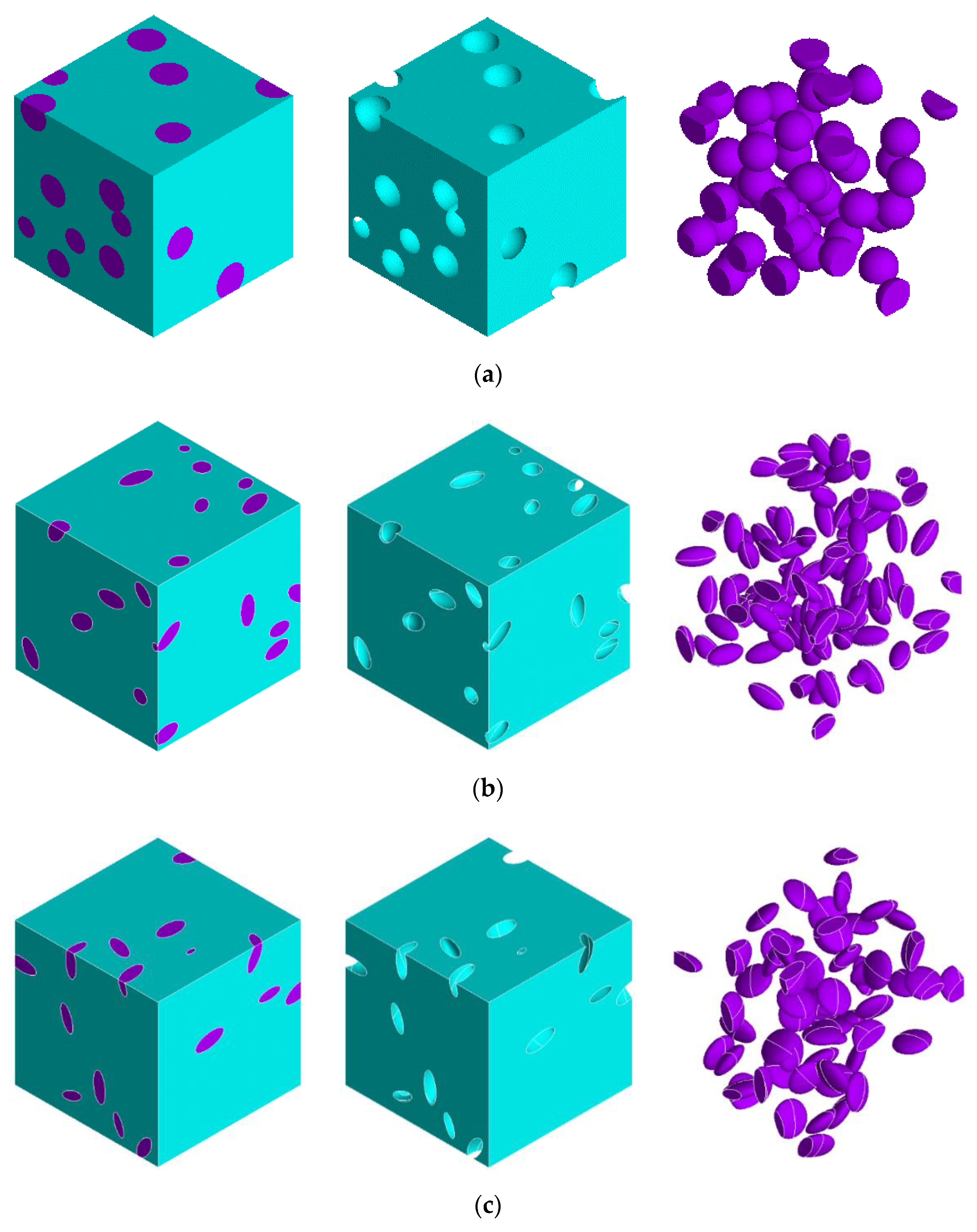
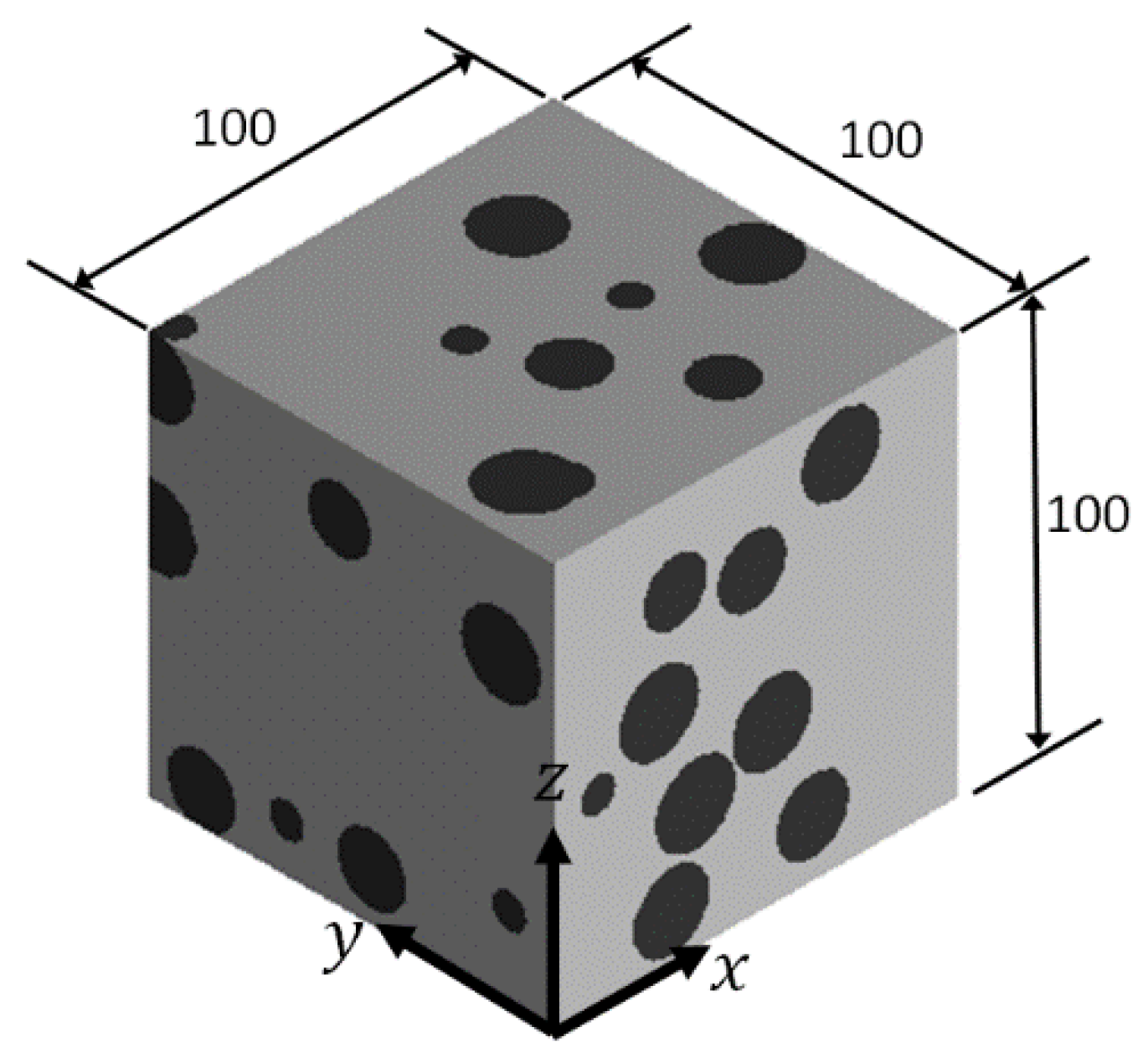

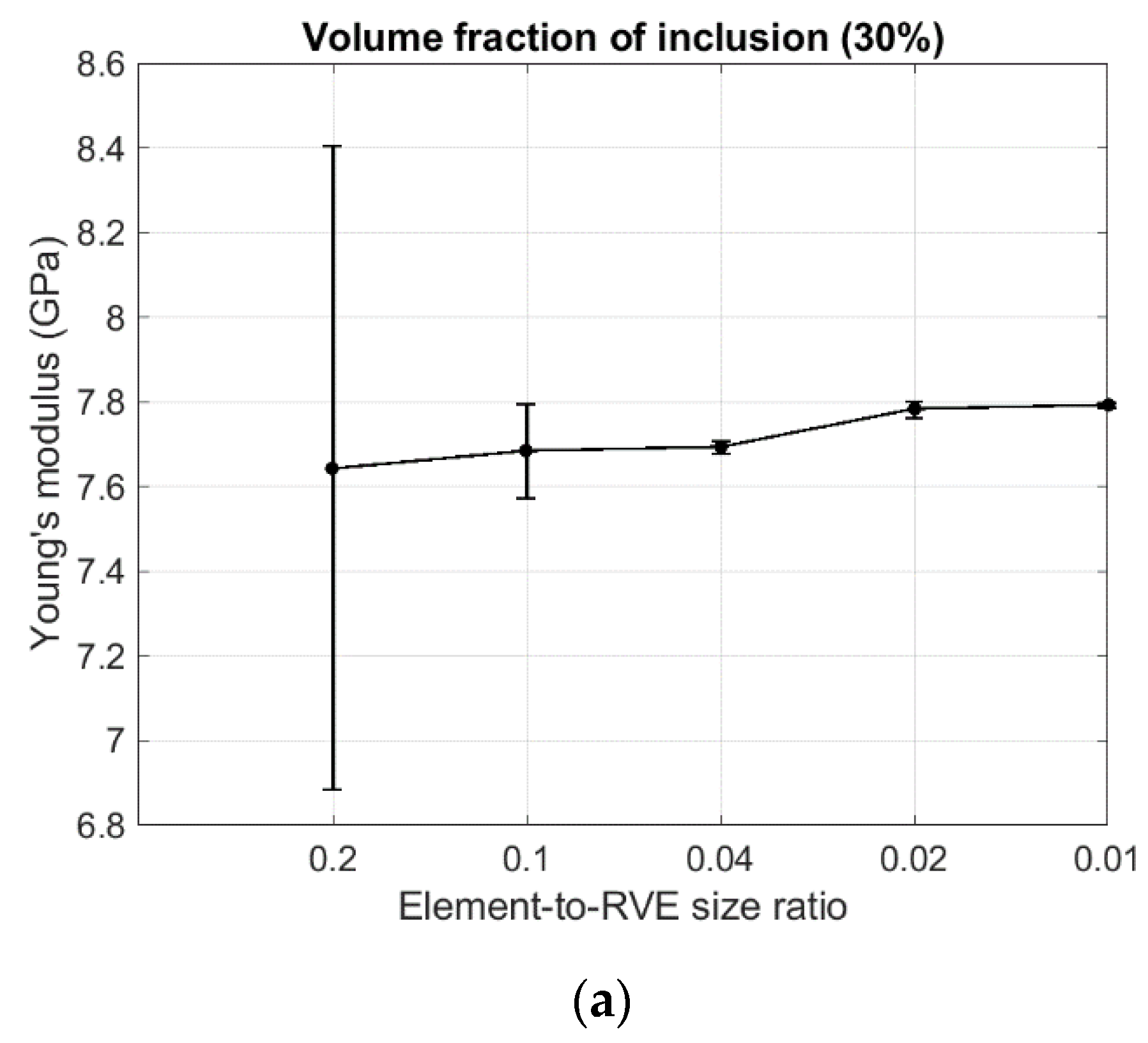
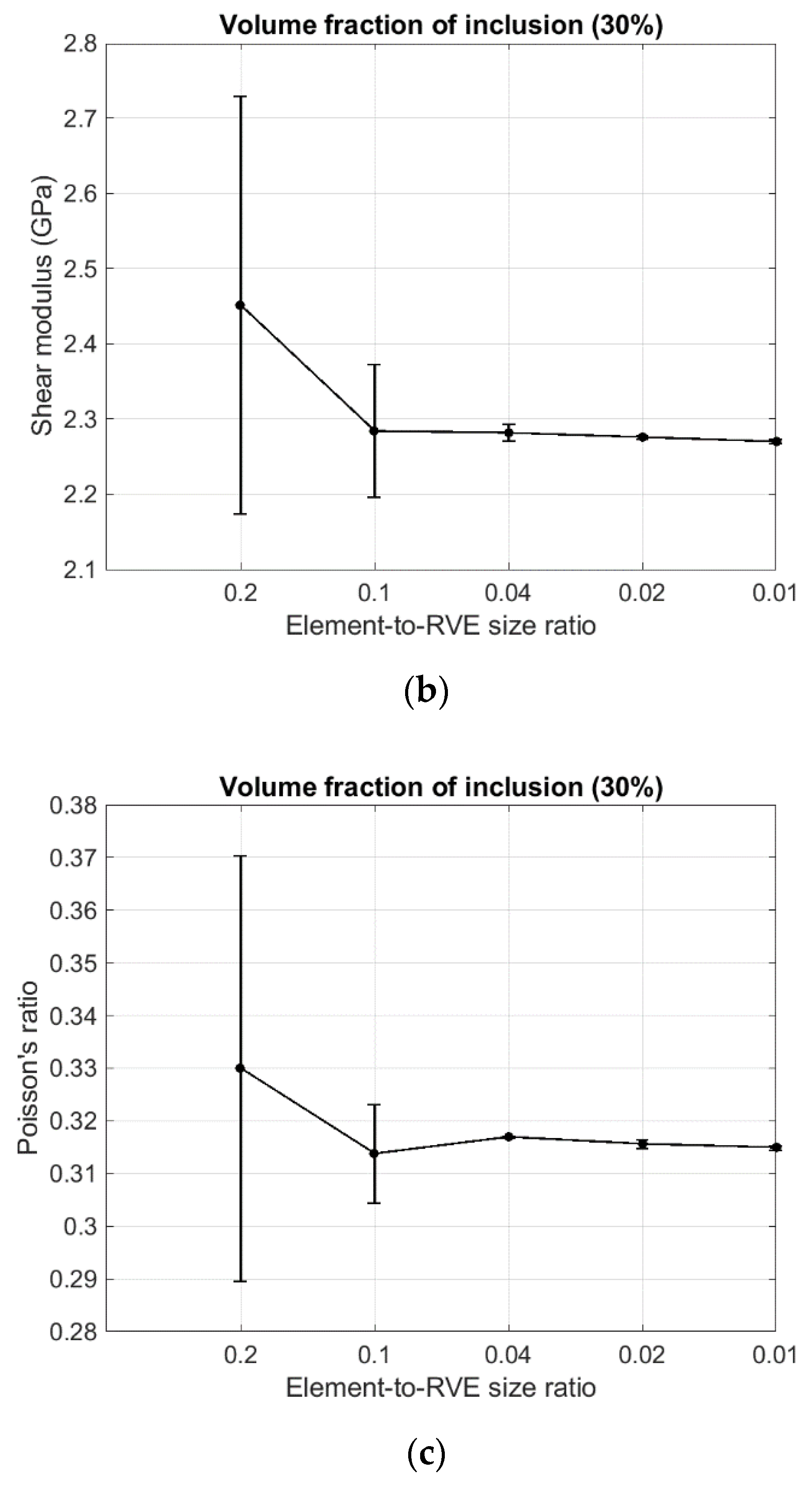

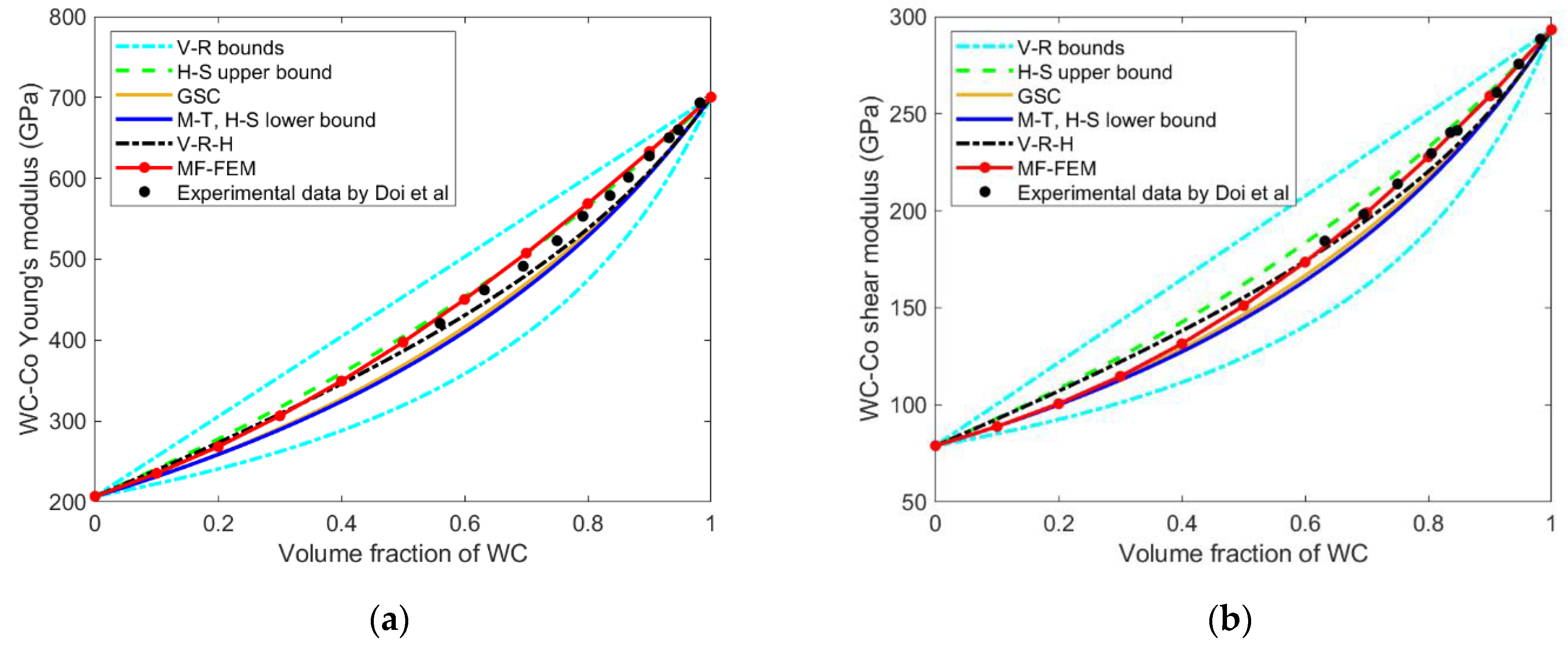

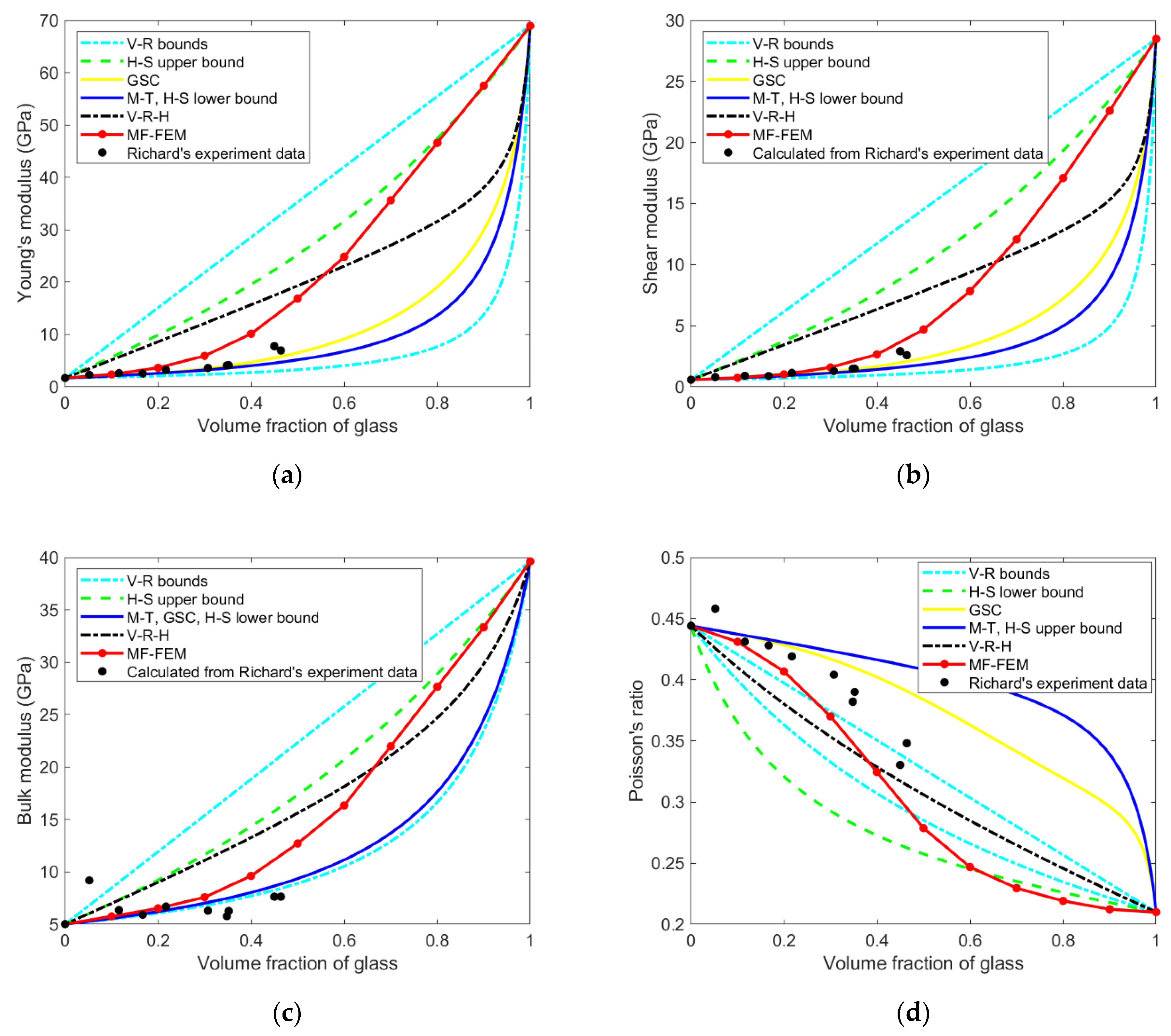
| RVE Surface | Young’s Modulus (Ei, i = x, y, z) and Poisson’s Ratio (νij, i, j = x, y, z) | Shear Modulus (Gij, i, j = x, y, z) | ||||
|---|---|---|---|---|---|---|
| Ex, vxy, vxz | Ey, vyx, vyz | Ez, vzx, vzy | Gxy | Gyz | Gzx | |
| x = 0 | ux = 0 | ux = 0 | ux = 0 | ux = uy = uz = 0 | Free | Free |
| y = 0 | uy = 0 | uy = 0 | uy = 0 | Free | ux = uy = uz = 0 | Free |
| z = 0 | uy = 0 | uy = 0 | uz = 0 | Free | Free | ux = uy = uz = 0 |
| x = 100 | ux = 1 | ux (coupled DOFs) | ux (coupled DOFs) | uy = 1, ux (coupled DOFs) | Free | Free |
| y = 100 | uy (coupled DOFs) * | uy = 1 | uy (coupled DOFs) | Free | uz = 1, uy (coupled DOFs) | Free |
| z = 100 | uz (coupled DOFs) | uz (coupled DOFs) | uz = 1 | Free | Free | ux = 1, uz (coupled DOFs) |
| Phase | Young’s Modulus (GPa) | Shear Modulus (GPa) |
|---|---|---|
| Cobalt | 206.99 | 79.00 |
| WC | 700.43 | 293.31 |
| Phase | Young’s Modulus (GPa) | Poisson’s Ratio |
|---|---|---|
| Polyester | 1.69 | 0.45 |
| Glass microsphere | 68.95 | 0.21 |
Publisher’s Note: MDPI stays neutral with regard to jurisdictional claims in published maps and institutional affiliations. |
© 2022 by the author. Licensee MDPI, Basel, Switzerland. This article is an open access article distributed under the terms and conditions of the Creative Commons Attribution (CC BY) license (https://creativecommons.org/licenses/by/4.0/).
Share and Cite
Luo, Y. Microstructure-Free Finite Element Modeling for Elasticity Characterization and Design of Fine-Particulate Composites. J. Compos. Sci. 2022, 6, 35. https://doi.org/10.3390/jcs6020035
Luo Y. Microstructure-Free Finite Element Modeling for Elasticity Characterization and Design of Fine-Particulate Composites. Journal of Composites Science. 2022; 6(2):35. https://doi.org/10.3390/jcs6020035
Chicago/Turabian StyleLuo, Yunhua. 2022. "Microstructure-Free Finite Element Modeling for Elasticity Characterization and Design of Fine-Particulate Composites" Journal of Composites Science 6, no. 2: 35. https://doi.org/10.3390/jcs6020035
APA StyleLuo, Y. (2022). Microstructure-Free Finite Element Modeling for Elasticity Characterization and Design of Fine-Particulate Composites. Journal of Composites Science, 6(2), 35. https://doi.org/10.3390/jcs6020035






